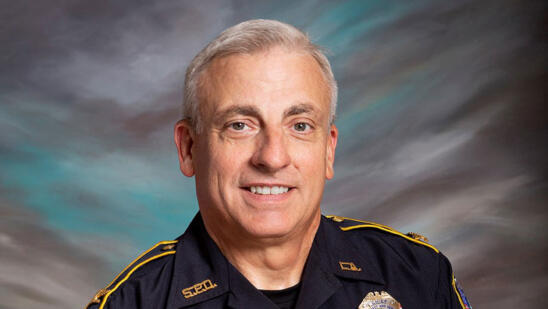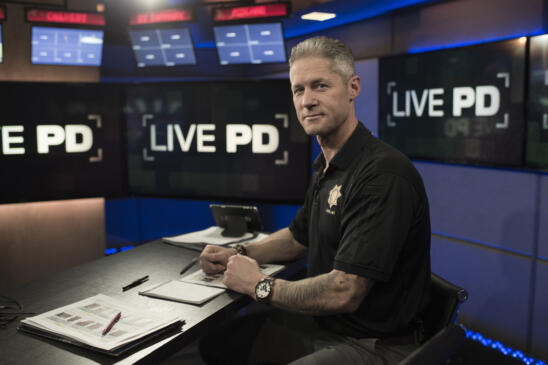You likely already know Sgt. Sean “Sticks” Larkin from Live PD. Now you can get to know him even better on the series, Live PD Presents: PD Cam. The show features entirely raw, unfiltered footage from police officers’ body cams, dash cams, helicopter cams and surveillance footage.
In each episode, Sticks, who’s part of the Tulsa Police Department Gang Unit, will also interview a police officer whose footage has been featured. He describes these conversations as “strictly unscripted—basically just two police officers talking about an incident,” saying he has “a personal, raw feel between myself and whoever it is I’m talking with.”
A&E True Crime spoke with Sticks about misconceptions about body cam footage, what it’s like to wear a cam and more.
What is it like to wear a body cam?
I’ve been a cop for 21 years, and in Tulsa [they were introduced] about a year ago. When you’re out in your police car, you’re on your own—you’re kind of your own boss. So, when you first start wearing the body cam you’re very apprehensive about it. Then…it’s great; you’re capturing evidence, things that happened, on tape.
[Now] when you go into court, the tape shows exactly what you’re saying happened. It’s just getting used to that. You actually start to see, Hey, this thing is helping us, as opposed to [feeling like] you’re being watched by ‘the man,’ so to speak.
Are you conscious of it when you wear it?
I am now. In most departments it doesn’t [stay on for the entire shift] just because of the amount of data that it ties up.
We’re supposed to activate it when we go on a search warrant, and when I first started wearing it, we would go and all of a sudden one guy would go, ‘Oh, man, I forgot to turn my body cam on.’ Then two other people are like, ‘Me too!’
So now when we do go on search warrants, there’s one [officer] who says, ‘Everybody turn on your body cam,’ and then everybody turns it on. [But now] it’s kind of second nature—everybody’s used to them.
What happens if a cop turns off the body cam?
Every department has a policy on the use of the camera. The generic warning for ours is, basically, if you’re taking enforcement action, it needs to be on. If you’re chasing a suspect and you turn it off, there are going to be some questions on why [it] was turned off, so [you’d] better hope your camera had a malfunction.
So you’re allowed to turn it off when you go to the bathroom?
Actually, yes! That’s not an enforcement type of thing.
Do you ever forget to turn it off?
I have not forgotten yet. Even when we’re on car stops, [when] we get back in the car, we [say], ‘You got your camera off?’ Once we start driving, some of the conversations in those cars are just two guys having conversations about anything in life you can think of. It might not be the most professional conversation at times; it’s just two guys talking.
Is the public always allowed to see body-cam footage?
Just when it’s released. Different departments have different policies on it. Here in Tulsa, our chief has been pretty good about it from the get-go, as far as releasing things, especially if there’s something that our department perceives as high profile or having a public interest. We have a media portal and our local media agencies and news agencies here have access. They’re all going to get the same video at the same time.
Then there’s the other thing where people–whether it’s the media, the public or attorneys— will file open-records requests and get it released. But if someone want to just go, ‘I want to log on and see what Sean Larkin was doing,’ it doesn’t work like that.
So it’s not just like a live stream.
No. And people would probably be pretty bored at times.
What are some of the biggest misconceptions people have about body cams?
For the most part, they’re not on all the time. So not every single thing is going to be captured on there. Another thing people get wrong is [they] think [the camera] is going to see every single thing that happens, and that’s not the case.
The body cam only shows the direction that it’s facing. We wear ours on our vest, mounted on our chest. It’s going to show what’s in front of me, and it’s kind of a fish eye. But if I’m sitting in my car while I’m out somewhere, and I turn my head to the left, I’m going to observe something that the camera [doesn’t see]. So if I say I observed something, it doesn’t mean I’m lying because it doesn’t show it on the camera. It is a huge help, but it does not show everything.
Can you tell us about the other cams that we’ll see on Live PD Presents: PD Cam?
Sometimes there are multiple officers on a scene, and on the show, you’re going to get to see several different angles. It’s not like having one cameraman there. You might have, essentially four cameramen—which are the officers—and then you’ll have their dash cam. And then if there’s something really cool, there are helicopters overhead also recording. That’s the beauty of it—having multiple officers on the scene with different cameras.
How do you feel about the show as the series premiere gets closer?
I’m super nervous about it, but I’m really excited. The footage itself is going to be amazing, but the interviews are really going to make this thing stand out.
When you announced it on Twitter, you seemed relieved to be able to talk about it.
I was! What was funny was that I actually wasn’t on Live PD that weekend. I was in Tulsa, and I wasn’t even watching the show. I was out that night with some friends, and all of a sudden I got a message from my mom, who was watching Live PD, and she was like, ‘Oh my God, this commercial!’ And that’s how [I found out].
For more from Sticks about the Tulsa Gang Unit, listen to Episode 1 of the PD Stories podcast. For more information, visit the PD Stories page.
Related Features:
Sgt. Sean ‘Sticks’ Larkin on How Surveillance Footage Helps Police Investigations
Sgt. ‘Sticks’: ‘I’m Just a Regular Dude’


